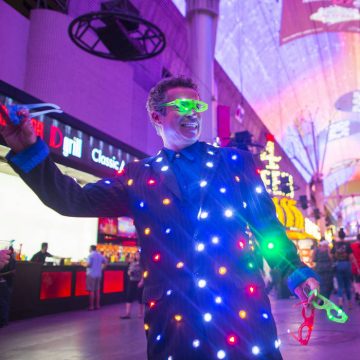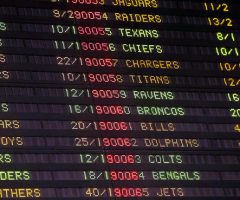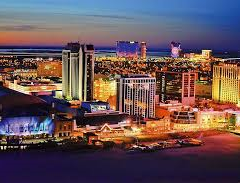
For years, Las Vegas officials have used 6-foot poker chip circles on the ground to help maintain order among street performers at the Fremont Street Experience. A 2015 lottery system to see who occupies the poker chip designs, so buskers do not fight over territory.
Before the new system was put in place, entertainers had controversies and rivalries for space on Las Vegas’s showiest non-gaming attraction. A few high-profile incidents gave the area a public relations black eye with officials and tourists. After a lawsuit and a judge’s order, the lottery system has been tweaked.
Performers still complain about the system, but tourists give largely positive feedback on the Fremont Street Experience and the free concerts which take place their. Some of the complaints by the buskers and other performers involve the private security staff used by the Fremont Street Experience’s president.
Fremont Street Experience LED Canopy
The Fremont Street Experience is an attraction in Downtown Las Vegas. In all, the 5-block “Glitter Gulch” includes a world-famous barrel vault canopy, a pedestrian mall, and street performers.
As people walk underneath the LED canopy, they see see an electric sign complete with 2.1 million incandescent lights. Light and sound shows are presented every night at dusk on the Viva Vision video screen.
On the street below, free entertainment is provided on three stages. The Neonopolis shopping complex provides retail opportunties, while the SlotZilla zipline allows customers to travel “superhero-style” over the pedestrian mall.
Fremont Street Performers Criticize the System
Showy street performers are a part of the entertainment. The list of entertainers include buskers, performance artists, living statues, celebrity impersonators, and a variety of other gaudily dressed performers. These people vie for prime locations to perform, hoping for tips from passing tourists.
In the past, jockeying for position among performers has led to confrontations. Some entertainers develop rivalries or personality conflicts. When tensions become confrontrations, this tends to drive off customers. Las Vegas and Fremont Street officials wanted to cut down on such incidents, so they devised a system.
Poker Chip Designs Mark Territory
The system includes 6-foot radius poker chip circles now dot the pedestrian mall on the 5-block area ranging from Main Street to Las Vegas Boulevard. The poker chip circles designate areas where entertainers can perform. Once, buskers and other performers tussled for spot, but a system now maintains order.
Jared Carle, who performs as a satyr — a half-man, half-goat out of Greek myth — says that competition for the best spots is fierce. Carle said, “People are vying for these places like they’re real estate.”
Poker Chip Lottery System
A lottery system put in place in 2015 now determines who gets the 38 poker chips each night — and when they get the chips. Players win a spot for a two-hour window at a time. The lottery applies for times between 1pm and 3am, which are considered prime time for tourists.
At one time, all street performers were required to participate in the lottery. Busker Bruce Peck challenged that ordinance as unconstitutional in October 2015, days before the new rules went into place. U.S. District Court Judge Jennifer Dorsey upheld large parts of the policy, but kept most parts in place.
Judge Dorsey ruled that the ordinance does not aim to regulate the performances, a complaint Bruce Peck and others had. Instead, Judge Dorsey ruled that the lottery was “narrowly tailored to serve a government interest.” She ruled that performers could take up a position in the poker chip circles anytime after 3pm, if the circle is free of a prearranged performer.
2011 ACLU Case over Expressive Activities
The court case was not the first time the Fremont Street Experience has been the focus of a legal battle. City officials long have contended that tourists complain about “racy attire and vulgar signs” along the Fremont Street Experience. In 2011, an attempt to set policies on costumes and regulate the signage led to a lawsuit over “expressive activities“ by the Las Vegas chapter of the ACLU.
Now, city officials do not make changes to the performance rules until consulting with the ACLU. Las Vegas City Attorney Todd Jerbic said, “We learned our lesson the first time.”
Still, performers say they feel unprotected on Fremont Street. The uniformed Fremont Street Experience security officers who roam the area do not have the authority to arrest or cite people, but buskers say they have been hassled by them. Casinos along Fremont Street do not want buskers performing outside their doors, and buskers allege security officers (called “blue shirts” by locals) sometimes hassle them on behalf of casino ownership.
Fremont Street’s Security Officers
Balloon artist Heather Baressi said she has been attacked on several occasions. Baressi said, “There’s nobody making sure our rights are protected.”
Fremont Street Experience President and CEO Patrick Hughes disputes that contention. Hughes says that the blue shirts do not work for the casinos. Instead, a team within the security officers works to educate the public and performers on local ordinances.
Jared Carle splits the difference. He says that the security officers’ interactions with performers depends on the officer on the scene, including their interpretation of performances and how aggressive their style is. Carle said, “It depends on which security guard rolls up. They’re going to make a determination of whether it’s entertainment or not, and whether they belong in a circle.”
It is an imperfect system. While the performers chafe at how the system is implied, city officials contend that tourist feedback is largely positive. Visitors seem to think the right balance has been struck. Jerbic, the city’s lawyer, responded to charges of unfairness by saying, “We don’t work for the casinos. We don’t work for the performers. We work for the public. We are here to strike that balance.”















